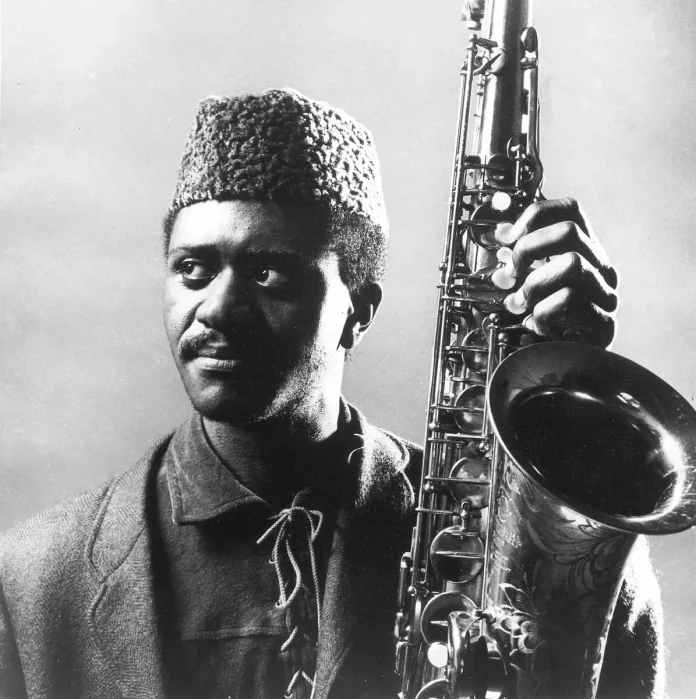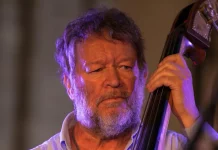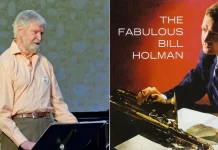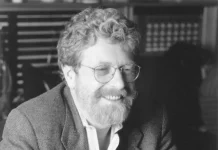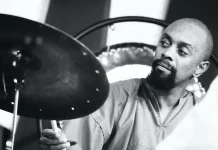Saxophonist Pharoah Sanders, responsible for decades of spiritually rich and emotionally unflinching music, died at age 81 on 24 September 2022. Somewhere in the sky, the celestial bodies are celebrating the return of one of their own.
Sanders became known for his singular tonality and decidedly lyrical style of playing; with overblown shrieks, towering multiphonics, hypnotic “sheets of sound” and sonorous melodies. He first rose to prominence with his work alongside John Coltrane during the latter’s avant-garde, spiritually motivated free-jazz period. After Coltrane’s death, Sanders would go on to release a number of his own seminal free-jazz and spiritual-jazz albums over a decades-long career.
Farrell Lee Sanders was born in Little Rock, Arkansas on 13 October 1940, an only child. His mother was a cook in a school cafeteria and his father worked on the city transit. The family always loved music, and it didn’t take long for young Farrell to reveal a natural aptitude for making the stuff. He began, like many greats, in the church, first playing drums, then clarinet, until finally landing on the instrument that would carry him to greatness and beyond.
The saxophone provided Sanders with his first professional gigs; as a teenage boy, he found himself supporting R&B acts like Bobby “Blue” Bland and Junior Parker at local Little Rock clubs. Quickly, Sanders knew he had found his calling, but those early days were far from wine and roses. Little Rock in the 1950s was, of course, deep in the throes of segregation, and Sanders would often find himself performing while obscured from the view of white audiences.
“I played lots of jobs like that – you know, behind the curtain,” he recalled in a 2016 interview. “But I never let that stop me.”
The jazz bug bit Sanders in a big way, and he heard legends like Charlie Parker and James Moody calling his name out on the coasts. At age 19, he moved to Oakland, California and joined the Bay Area’s robust jazz scene. San Franciscan jazz was at a peak in the late 50s and early 60s, with scores of talented players and one of the all-time great American jazz clubs in Jimbo’s Bop City.
They called him “Little Rock” at first. Hayseed nickname or not, Sanders quickly built a tidy reputation in the Bay Area’s R&B and bebop circles and found himself playing with talented innovators like Sonny Simmons.
In 1961, at the San Francisco Jazz Workshop, Sanders met another important jazz figure who would go on to be a pivotal figure in his career: John Coltrane, fresh off of Giant Steps. Immediately, he found himself drawn towards Coltrane and his immense talent.
“He had that vocal sound”, Sanders reflected, “ – very human, very soulful. It had an edge. . . I said ‘Oh man, I’d love to sound like that.’”
Coltrane represented a change in the seasons for Pharoah Sanders. Without question, something new and exciting was going on in the jazz world, and Pharoah Sanders was ready to join it. It was (skilled saxophonist and multi-instrumentalist) John Handy who convinced Sanders to pack up his things once again and head for New York City and the burgeoning free-jazz movement.
So once again, Sanders hit the road for bigger things. Unfortunately, as it has so often been known to do, New York had other plans. Upon arrival, Sanders struggled; finding himself unable to make a living through music alone, he worked odd jobs and was often homeless, resorting to sleeping on the subway and couch surfing. Sanders even pawned his beloved horn to make ends meet.
Even while down on his luck, though, he continued to play with some of the most talented innovators in jazz. One of the couches where Sanders would seek respite belonged to Sun Ra, who also offered clothes and counsel. It was Ra who initially suggested that Sanders start going by the uniquely spelled Pharoah, and gave him a spot in his Arkestra. The newly minted Pharoah Sanders played with other forward-thinking minds like Don Cherry and Billy Higgins, once again building a name for himself as one of the foremost young talents on the scene. There was a seeming wildness to Sanders’ tone – intense and sometimes alarming (even now) to unfamiliar ears. However, beneath any perceived abrasion, behind every note, honk or scream, there lay an undeniable, deeply lyrical and highly emotive quality.
In 1963 he formed his own group, with drummer Billy Higgins (who had played with Ornette Coleman in the 50s), pianist John Hicks, and bassist Wilbur Ware. They gained a reputation as being on the cutting edge of the cutting edge, largely thanks to Sanders’ horn.
In 1964, Coltrane asked Sanders to sit in with his group. Within a year, Sanders had been made a full-time member of the group, bringing with him his immense, overblown tones and shrieking dissonance. The first recording he appeared on with Trane was 1965’s Ascension; considered the pivot between Coltrane’s earlier, more conventional work, and the free-flowing avant-garde space he travelled through in the final years of his life.
The dual-tenor masterwork Meditations followed shortly thereafter, capturing intense and gripping conversation between the two titans’ horns. Meditations and the two years of experimental free jazz recorded by Coltrane with Sanders were immediately controversial and influential in equal parts. Even McCoy Tyner and Elvin Jones were unsure of the sound, leaving the group shortly after Meditations was released. Tyner, in a 2001 interview, described Coltrane as “constantly pushing forward”, adding: “He never rested on his laurels, he was always looking for what was next . . . always searching, like a scientist in a lab.”
Coltrane’s insatiable hunger for advancement found a hell of a meal in Pharoah Sanders. His tenor saxophone became more expressive than ever before
Coltrane’s insatiable hunger for advancement found a hell of a meal in Pharoah Sanders. His tenor saxophone became more expressive than ever before and the back-and-forth between the two musicians seemed to dive into the deepest corners of the psyche and soar beyond the furthest reaches of the cosmos. Sharp, guttural screams, sonorous melodies, the pair’s famous “sheets of sound” . . . all present their messages in turn, never competing and building to produce something entirely new, yet deeply inherent and human.
Eventually, the group solidified as a quintet featuring Coltrane and Sanders on horn, Coltrane’s second wife (and jazz and spiritual legend) Alice on piano, Rashied Ali on drums, and classic quartet bassist Jimmy Garrison. In live performance, they would stretch compositions towards an hour in length, passing off extended solos. The music’s spiritual quality was undeniable, and each member was given their time to express their own personal musings. Listening is a three-dimensional experience, like watching an all-encompassing film.
If that quintet was a masterful flick, Pharoah Sanders was an actor chewing all the right scenery. His presence was unmistakable; at times overwhelming, at others gentle and subdued. After Coltrane’s death, plenty of eyes turned his way. With or without Trane, Sanders had plenty to say.
He continued working with the Impulse! label, releasing a string of solo records considered by many to be his finest work. The first was the mystical and contemplative Tauhid in 1967, equal parts moving, funky and freaked-out.
Next came Karma, among the most important pieces of spiritual jazz ever released. It opens with the 30-minute epic The Creator Has A Master Plan, often regarded as Sanders’ magnum opus. It’s a piece that transcends genre, moving into a space of pure emotion with the ethereal, otherworldly sounds produced by Sanders balanced by the warm, grounding presence of vocalist Leon Thomas.
In the late 60s, Sanders continued working with Alice Coltrane, notably on her spiritual epic Journey In Satchidananda. Despite being somewhat overlooked at the time, Satchidananda has proven to be incredibly long-lasting and impactful. The spiritual wavelength the two masters explore brings the music to another wholly unique space, like wrapping your soul in a warm blanket.
Sanders continued to release his own music with Impulse! until 1973 – albums that explored a myriad of influences and a variety of instruments. Reed flutes and bass clarinet featured heavily on 1969’s Jewels Of Thought, and Sanders played balaphone, percussion, cow horn – plus tenor, alto and soprano saxophone – on 1971’s Thembi. There was a distinct Afro-Latin bent to his compositions on 1970’s Deaf Dumb Blind (Summun Bukmun Umyun) and 1971’s Black Unity, which also incorporated elements of aborigine and native American music.
After his departure from Impulse!, Sanders came somewhat adrift; the free jazz he had built his name on had rather fallen out of fashion and he was eager to try new things. On Clive Davis’s Arista Records, Sanders delved back into the R&B world and even dipped his toes into disco. In the 80s and 90s he played and recorded with international musicians, making Gnawa music in West Africa and performing ragas in India. Sanders’ philosophy of communion through music allowed a degree of interpersonal connection with artists that spoken language would not as easily allow, and those records reveal the fruit of that interconnectivity.
Sanders also returned to the classics, releasing a pair of albums featuring a number of standards and appearing extensively on McCoy Tyner’s Grammy-winning 1989 work Blues For Coltrane: A Tribute For John Coltrane. Sanders relaxed his style a bit for the standards: there was still an occasional scream, but his playing had cooled down into something more accessible and mellow. Some long-time fans and critics were confused by the perceived “softening” of Sanders’ style – something he found amusing.
“I don’t worry about who writes stuff like that,” he laughed in a 2004 interview. “I don’t listen to stuff like that, it doesn’t bother me one bit. I just go and play and play for people who want to hear my music.”
In 2016, Sanders was selected as a National Endowment for the Arts Jazz Masters Fellows. In the video that accompanied that honour, a number of modern jazz greats spoke with reverence about Sanders’ moving genius.
Kamasi Washington said “It’s like taking fried chicken and gravy to space and having a picnic on the moon, listening to Pharoah.”
According to Christian McBride, Sanders “has a special line to a very spiritual pool that I don’t think most people have, which makes sense as to why John Coltrane would want him at his side”.
But the beauty of Pharaoh Sanders’ prolific output takes him beyond the jazz world. On his own website, his biography proudly states that “some of his best work is his most accessible”. And Sanders himself, in that same 2016 NEA video, smiles and says “I never look at the word jazz. I just play.”
We owe a sincere thank you to the great Pharoah Sanders for coming down from his astral plane for the last 87 years; may he fly high and far on his journey home.
R.I.P. Pharoah Sanders, 13 October 1940 – 24 September 2022.
Sam Feehan is a freelance arts & culture journalist with degrees in journalism and songwriting from the University of Southern California.

